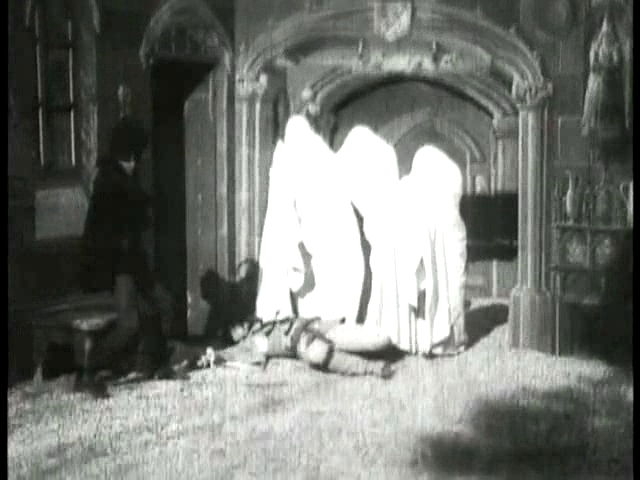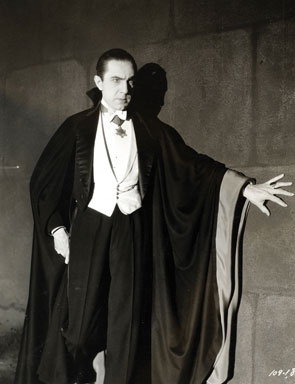
Figure 1 – scene from the world’s first “horror movie,” “Le Manoir du Diable,” or “The Manor of the Devil,” 1896. It was a three-minute-long film, released on Christmas Eve, 1896, at the Theatre Robert Houdin, 8 boulevard des Italiens, Paris. Here a gentleman is subdues by spectres. From the Wikimedia Commons and in the public domain.
Yesterday I wrote about “grade B horror” movies, which led me to wonder if there is such a thing as a “grade A horror” movie. After all, it is a peculiar badge of distinction to be referred to as a “grade B horror movie,” since it means “so bad as to be good!” Very confusing! OK, well to my original question, yes, I believe that there are “grade A horror movies.”
My son is probably shaking his head right now, since he knows what comes next. I believe the M. Night Shyamalan‘s “The Village” is a “grade A horror movie.” “What?” you ask. Yes, I am probably the only person in the world, who thinks that this was a great movie. Let me tell you why. “Please don’t,” I can hear my son saying. I like this movie because it transcends the genre. It is more than a scary movie. It is filled with wonderful mythic illusions. Ivy is the classic “hero of a thousand faces.” She is the Savior. She is blind and the only one who sees. When the creatures attack, and she is left alone on the porch, she puts out her hand knowing that Lucius will be there to rescue her – come on, am I the only one who feels this? And when she is abandoned by her fellow travelers in the quest (Psst! It’s the story of the Quest for the Holy Grail.”) – she tosses away the protective pebbles – knowing that her strength must come not from superstitious magic but from within herself. Really? Nobody else feels this with me? Hmm. Did I mention that the evil critters are the spittin’ image of something out of a Hieronymus Bosch painting?
The point I am making is that a story is a story – a photograph is a photograph. But when it resonates with our collective mythology it transcends itself and becomes something much more. We all, well most of us, love a good vampire story. And, if you do, take a look at this gorgeous still from F. W., Murnau’s 1922 terrifying (in a 1920’s kind of way – which means that my mom and her friend Becky probably screamed their way through it), Nosferatu, eine Symphonie des Grauens. Vampires appear to be ageless. Bad! And part of that agelessness is that the story resonates deeply with religious mythology. Blood as a regenerating fluid runs to the deepest fertility myths of our distant past. And the story of the vampire is the story of the antichrist. In Christianity, the Christ give eternal life through holly communion, and in the Legend of the Vampirethe antichrist vampire appropriates this and gives eternal life through unholy communion. Kinda cool stuff for sure.

Figure 1 – The great Bela Lugosi as “Dracula, 1931.” Image from Universal Studios via the Wikimediacommons, out of copyright and in the public domain.
Indeed, what separates good horror fiction from bad is a consistency of story. Establish the boundaries of the possible – somewhere beyond what is truly possible – and stick to your own rules. What separates great horror fiction from good is deep resonance with our collective myths. Did I mention great writing, acting, and cinematography?
With photography this all gets very interesting. There are few who really attempt to make the transcendent leap from beautiful reality to a mystic mysticism. The Victorians, of course, dwelt there for a while. Witness: Julia Margaret Cameron and Oscar Reijlander. Theirs was a very traditional Christian mythology. The great master, in my view, was Annie Brigman. Consider her beautiful “Figure in a Landscape.” This is not just a naked lady out for a swim. We are bombarded by allusion. She is the water nymph, a symbol of the virgin wilderness. She is the spirit of the lake, Sir Thomas Malory’s “Lady of the Lake.” And, I think at a very different level, she is the youth confronted with endless possibility.
I would challenge all of you, as photographers, to attempt such a transcendent image. It is not easy, even if you have robed or disrobed people ready and willing to pose for you. To do this well is very difficult. Fumbling to cliche’ is a much more likely result. Even attempting a seductive vampire photograph without appearing silly is a major artistic challenge.
I read and follow a number of excellent photography user’s groups and it never ceases to amaze me now many talented photographers are out there. The comments are usually terse, like “great” or “fabulous shot.” Most of the time we are praising the technical: composition or dynamic range for instance. These evoke a great aesthetic feel! In a select number of images, there is something unique, something that really catches your eye – something which demonstrates a real vision on the part of the image maker. The rarest group of all are those which set off the neuro-fireworks of out collective mythology. Like fine wine these resonate with our deepest sense of the artistic.

Pingback: A few odds and ends | Hati and Skoll Gallery